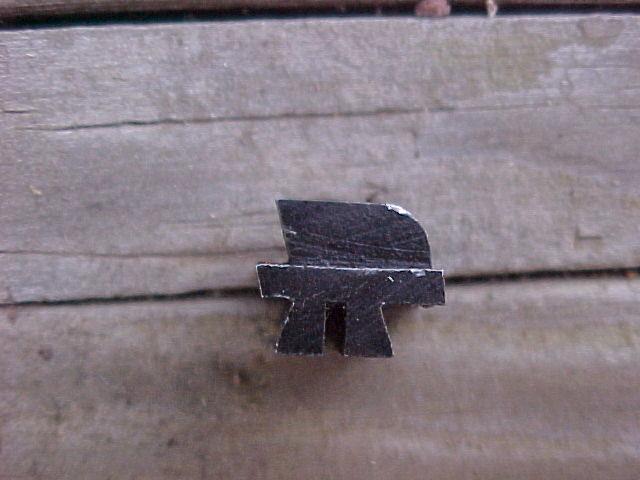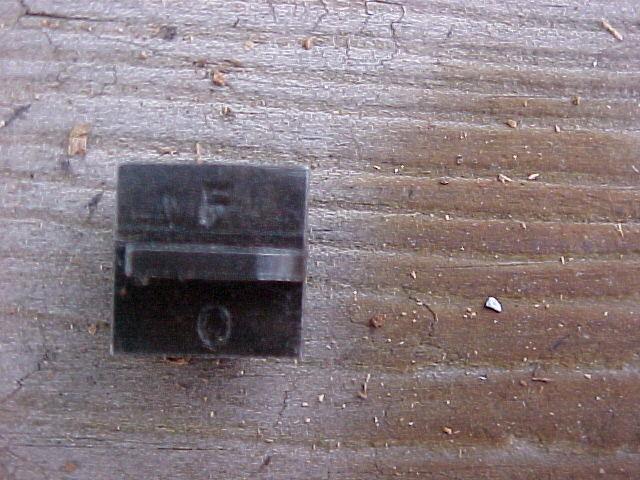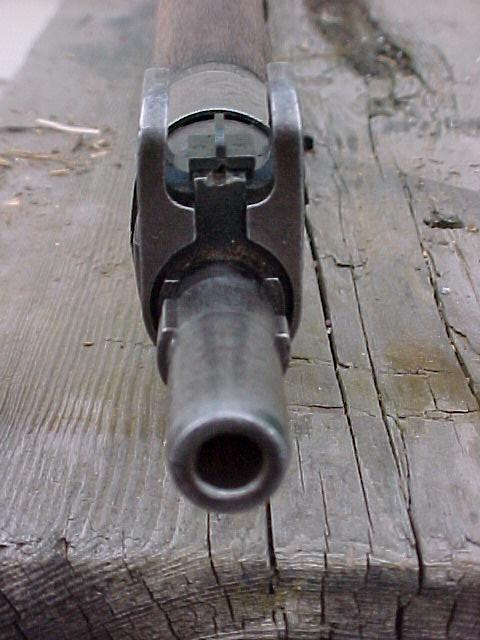-
Legacy Member

No.4 Sight Block
I've recently seen one without a tightening screw at the front, was this a wartime expediency?
Information
 |
Warning: This is a relatively older thread
This discussion is older than 360 days. Some information contained in it may no longer be current. |
|
-
-
07-02-2019 04:14 PM
# ADS
Friends and Sponsors

-
Legacy Member

Two types Mick, Screw at front uses the split dovetail foresights, the solid block, no screw, uses solid dovetail foresight blades.
-
Thank You to Roy W For This Useful Post:
-
-
Advisory Panel


It's actually just the opposite. Split blades in the solid block, (Mk.2), and solid blades in the base with the screw, (Mk.1).
-
Thank You to Brian Dick For This Useful Post:
-
Don't forget that there are SEVERAL variations AND HEIGHTS for the foresight blocks and blades of course, that you should all be aware of. I wrote a paper about the why's and wherefores a couple of years ago. Maybe it's time for a computer whizz-kid to resurrect the post and put it up again
-
Thank You to Peter Laidler For This Useful Post:
-
Legacy Member

Don't forget that there are SEVERAL variations AND HEIGHTS for the foresight blocks and blades of course, that you should all be aware of. I wrote a paper about the why's and wherefores a couple of years ago. Maybe it's time for a computer whizz-kid to resurrect the post and put it up again
FORESIGHTS and the No4 rifle
________________________________________
Sights and the No4 rifle.
A bit of heavy weekend reading for you.......................
There has recently been some too-ing and fro-ing correspondence about the sights used on the No4 rifles. Maybe it’s time to open up a few little previously unknown or certainly not fully understood points.
Let’s take the foresights first. For the No4 rifle, there were 4 distinct TYPES of foresight blade. The very FIRST was, naturally enough, designated the
BLADE, foresight. It came in eight sizes, from -.030”, -.015, 0, +.015”, +.030”, +.045”, +.060” and +.075”. These sizes (and I’m sure you all know this by heart…..) indicate the tip of the blade height below or above 1” of the exact centerline of the bore while the blade size ‘0’ is exactly 1” above the centre line of the bore ……, phew! Now for another misunderstood point. All of the actual BLADE heights are the same of approx .140” but it’s the .38” wide blade BASE (or stool) height that differs to make up the sizes. I know that some of you will say that this isn’t correct because ……… I know this and that’s because some of the commercial companies, including Parker Hale made their own variants including thinner widths, blow-up tyres and wind-up windows etc. BUT I’m talking about the Ministry of Supply/Army issue blades
This blade was followed by a later blade style so as a result, the first original blade was redesignated the BLADE, foresight, Mk1. The Mk1 blade is easily identifiable by having a SOLID base. This is because it was retained firmly in position, gripped by the split BLOCK, band, foresight. The split foresight block is closed, to grip the solid blade, by a reverse headed screwdriver. It is the REAR of the Mk1 blade that we ought to be aware of now, where the undercut/inward sloping blade part meets up with the block, which then slopes outwards towards the base of the block. So, the side elevation of the blade forms a side-on ‘V’ shape.
This rearwards and upwards sloping base could and did allow a line of reflected light to shine straight back into the shooters eye. Maybe not on the manicured ranges at Bisley but it certainly did in the bleak sunshine of Tunisia and Italy from where the complaints came
from where the complaints came
The next foresight blade was introduced as a result of efforts to cheapen the cost of the No4 rifle in 1941. This time, instead of using a split block, band, foresight and the reverse headed 4BAscrew, the block, band was left solid. But in accordance with good engineering practice and to maintain the required friction to hold the blade secure within the block band foresight, the BLADE base was manufactured with a split block. This split block blade was called the BLADE, foresight, Mk1*
The sizes remained the same as did the zeroing procedure, as did the side-on ‘V’ side elevation of the rear of the blade. It’s just that the block was easier and cheaper to manufacture. The new slot made very little difference to the cost of the blades because a), they were manufactured ‘biscuit-block (some call it chocolate block) fashion anyway and b), the addition of a simple slitting saw operation along the base was an almost academic addition and c), the original blades were still being produced anyway!
So there you have the earliest Mk1and Mk1* blades.
Now here is where we get a little more complicated. The Mk2 blade…………. The Mk2 blade was very similar to the Mk1 blade with its 8 sizes and its solid block base only this time, where the undercut/outward sloping blade part meets the base part, the base extends rearwards a small amount, then the BASE takes on an undercut inward sloping angle too. This immediately solved the reflected light problem because now, both the blade and the base reflected downwards. This blade was introduced as the BLADE, foresight, Mk2
If things were simple, the next blade would be designated the Mk2* but we don’t do simple…., we do complicated! So, the next blade became the BLADE, foresight, Mk3. As you might expect, the Mk3 blade was identical to the double undercut Mk2 but this time came with a split base to use in the solid block band foresight.
The earlier Mk1 and Mk1* blades were thereafter, obsolescent. Obsolescent but not obsolete so there are thousands of thousands still in service……………
THE No5 RIFLE
If you have a No5 rifle, then a similar situation arose there too but the situation was even more dire as the reflected line of shine certainly DID cause problems. So while the No5 blades were all split blocks, the;
Mk1 split block blade for the No5 equates to the Mk1* blade for a No4 rifle
and the
Mk 2 split block blade for the No5 equates to the Mk3 blade for a No4 rifle.
There were different part numbers for the blades indicating that there were subtle differences between the No4 and No5 types. Quite what the differences between the blades were on paper didn’t manifest its way to us as young Armourers in Malaya! We used split block ‘double undercut’ blades on every No5 we zeroed of course, but they all came from the same tubs, regardless of whether it was a No4 or 5 blade. They all looked the same to us and we treated them the same too!
But back to No4 rifles and the BLOCK band, foresight. Are you in for the long haul? Soon after the large late 40’s FTR programmes, it was established at Fazakerley that a large percentage of fully refurbished rifles were impossible to zero due to them shooting too high. Fazakerley sought to obtain a relaxation in order to use the +.090” and +.105” STEN gun foresight blades but already there were problems relating to the final inspection standards that I won’t go into. But the same problems were apparent outside the factories and Base Workshops, in service too so while the factories, FTR programme contractors and the large REME Base workshops were NOT permitted to use the higher Sten foresight blades, a relaxation was sought that they could be used at unit level (both high sizes) and Field workshop level (just the .090 size). But this was palliative and not a cure by any means. The answer was that where a rifle was perfect in every other way, then a Mk2 BLOCK Band foresight was available.
The ‘new’ BLOCK, band, foresight was .030” taller, at .490” than the original Mk1 block band, at .460” tall. This immediately, but invisibly, allowed for a further 2 increases in blade height (……. think about it!). The new blocks can be identified by the figure 1H for the Mk1 split block or a 2H for the Mk2 solid block, marked on the rear sloping surface. But even these didn’t last long because they only allowed for a further two ‘invisible’ increases of foresight. The problem was more acute than that with thousands otherwise perfect No4 rifles stacking up in Ordnance depots unable to be zeroed So in an act of almost desperation in January 1954, two FURTHER foresight block bands blocks were introduced. These blocks were heightened by a further .030” to .520”. So we have the original block band height of .460”, the 1949 increased height to .490” then the 1954 block band with a height of .520”. At a stroke, we now have a block band foresight that allows the highest blade ( the .075”…., don’t forget that anything higher was for the Sten gun) to be, in effect .135”……… which is 1.135” above the centre line of the bore
So now we have a total of SIX BLOCK, band foresights.
The Mk1 and Mk2 original, the
Mk1H and 2H modified both .030” higher than the original, and the
Mk1 and 2 SECOND modified, now .060” higher than the original!
You’re not quite believing this are you? But help was at hand. The second block was pure duplication so was declared obsolescent. So that after 1954, only the first, original blocks and the third pattern, .060” taller were available from Ordnance stores. While the second pattern was obsolescent, you HAD to have the original, lower block of course in order to cater for those rifles firing LOW!
Jeeeees, we had to learn, know and put into practice all of this rubbish! The most astute of you will now be looking at your ‘original, untouched since the factory’ rifles to see if it has the higher foresight block band fitted. Only a post 1949 made rifle will have a block marked 1H or 2H and only a post 1954 made rifle will have a block marked 1 or 2 on the rear surface as original. Before that, they were bare!
But there’s a little more……………. Our acceptable zeroing standards state after zeroing, the blade of the foresight will overhang or be level with the edge of the foresight block. If the edge is inboard of the edge of the block, then it indicates that something is wrong with the rifle. BUT, it was discovered that while the UK made foresight blade bases were .38” wide, due to a tolerance error, the Canadian
made foresight blade bases were .38” wide, due to a tolerance error, the Canadian bases were .43” wide. Without going into the technicalities, a rifle fitted with a Canadian .43” wide base could fail the zeroing criteria unnecessarily. So these Canadian .43” wide blades were all declared obsolete and withdrawn.
bases were .43” wide. Without going into the technicalities, a rifle fitted with a Canadian .43” wide base could fail the zeroing criteria unnecessarily. So these Canadian .43” wide blades were all declared obsolete and withdrawn.
There, a little bit about a previously unknown feature of the No4 rifle! Not a lot of people know that!
Mine are not the best, but they are not too bad. I can think of lots of Enfields I'd rather have but instead of constantly striving for more, sometimes it's good to be satisfied with what one has...
-
The Following 6 Members Say Thank You to Alan de Enfield For This Useful Post:
-
Thanks Al. Phew....., that took the old memory cells back a bit. Good job it's all being written down and recorded for posterity on this forum. Can you imagine what it was like having to learn all of this crap now, under the beady eye of Stan Ayley our bolt action and principles of small arms instructor. Everyone with an original and unfired rifle ought to be taking a peek at his foresight block now
-
Thank You to Peter Laidler For This Useful Post:
-
Legacy Member


Originally Posted by
Alan de Enfield

Now here is where we get a little more complicated. The Mk2 blade…………. The Mk2 blade was very similar to the Mk1 blade with its 8 sizes and its solid block base only this time, where the undercut/outward sloping blade part meets the base part, the base extends rearwards a small amount, then the BASE takes on an undercut inward sloping angle too. This immediately solved the reflected light problem because now, both the blade and the base reflected downwards. This blade was introduced as the BLADE, foresight, Mk2
If things were simple, the next blade would be designated the Mk2* but we don’t do simple…., we do complicated! So, the next blade became the BLADE, foresight, Mk3. As you might expect, the Mk3 blade was identical to the double undercut Mk2 but this time came with a split base to use in the solid block band foresight.
So, this would be a MK3 blade?



-
-
Advisory Panel


-
Thank You to Brian Dick For This Useful Post:
-
Contributing Member


jeez, Peter
Do you know the Skeeter Davis song "I've forgotten more... than you'll ever know"?
-
-
It's just that the little things remind you. The other day it was a call from a friend about Bren barrel nuts and I remembered a small MI (that's a miscellaneous instruction) that came out that allowed........... anyway. It's the difference between the old, long time-served ex apprentices and the amateur enthusiasts. If it's not written down the reality and reasons get lost and the myths perpetuate. Have a great rest of the day and thanks for the kind compliment
-
The Following 3 Members Say Thank You to Peter Laidler For This Useful Post:















 PM
PM














